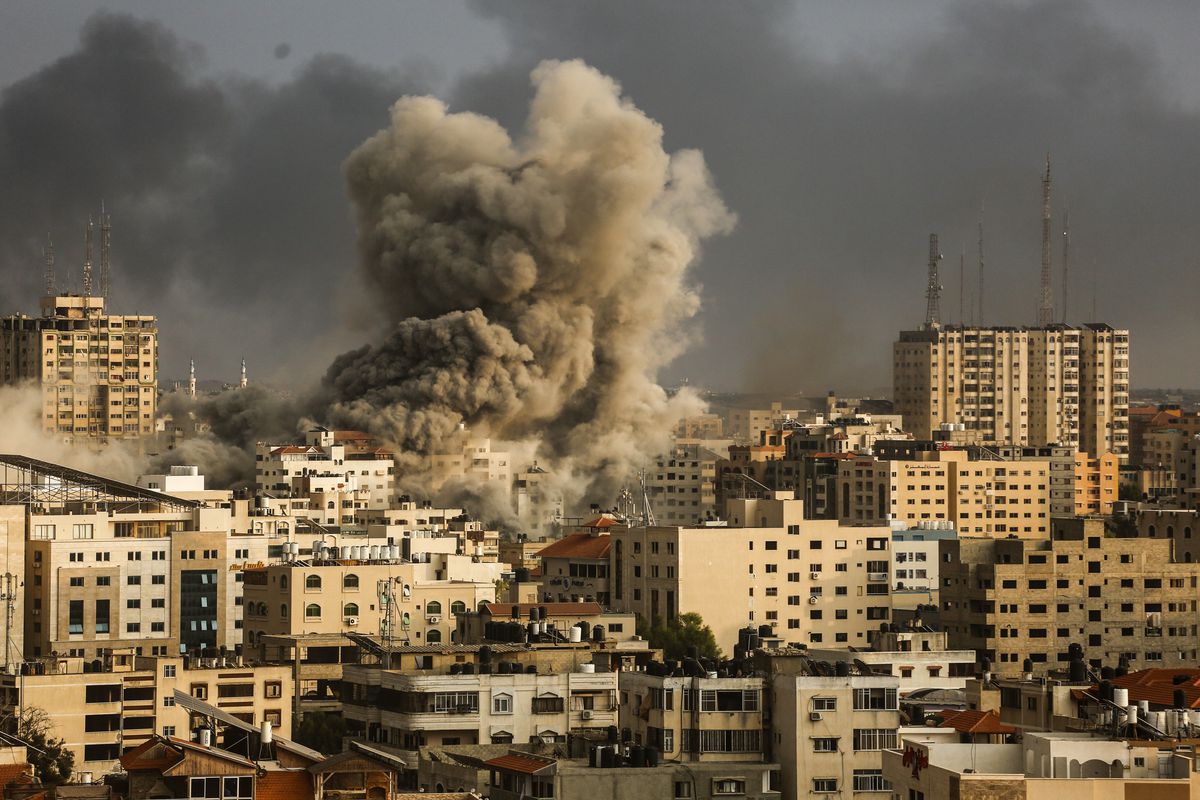Israel-Gaza war: a timeline of the conflict’s history
Originally part of the Philistine confederacy of five cities along the coastal plain, Gaza is mentioned in Biblical accounts, with the judge Samson being held captive there.
Gaza, situated on the Mediterranean coast where Asia meets Africa, has a rich history dating back thousands of years. This ancient trade center has witnessed numerous conflicts and has been contested by various empires and civilizations, including the Egyptian Pharaohs, Babylonians, Philistines, Macedonian Greeks, Romans, Arabs, Mongols, Crusaders, Ottomans, and even Napoleon.
Originally part of the Philistine confederacy of five cities along the coastal plain, Gaza is mentioned in Biblical accounts, with the judge Samson being held captive there.
The famous conqueror Alexander the Great besieged and captured Gaza City, resulting in the deaths of men and the enslavement of women and children. In Roman times, Christianity spread in the region, and a small Christian community still exists in Gaza, although their church has been damaged in recent hostilities.
Around 1,400 years ago, Arab armies arrived in Gaza, introducing Islam to the region. For the majority of the time between the 16th century and 1917, Gaza was under Ottoman rule as part of the Ottoman Empire. In the 20th century, Gaza saw a succession of transitions from British to Egyptian to Israeli military control.
Today, it is a fenced-in enclave inhabited by approximately 2.3 million Palestinians, many of whom are descendants of refugees.
The following are some key milestones in Gaza’s recent history, reflecting its complex geopolitical situation and ongoing challenges.
1948 – British Reign Ended
1948 marked the conclusion of British rule in Palestine. As this era came to a close, tensions escalated between the Jewish and Arab communities, ultimately leading to a war between the newly established State of Israel and its Arab neighbors in May 1948.
During the conflict, the Egyptian army invaded and took control of a narrow coastal strip spanning 25 miles (40 km), stretching from the Sinai Peninsula to just south of Ashkelon.
This military action resulted in a significant influx of tens of thousands of Palestinians who either fled or were displaced from Israel, seeking refuge in this coastal area. As a result, the population of the region tripled to approximately 200,000 inhabitants.
1950s & 1960s – Egyptian military rule
For a period of twenty years, Egypt assumed control over the Gaza Strip, appointing a military governor. During this time, Egypt allowed Palestinians to work and pursue education opportunities within its borders.
Notably, armed Palestinian “fedayeen,” many of whom were refugees themselves, carried out attacks into Israel, provoking retaliatory responses.
In response to the ongoing refugee situation, the United Nations established the United Nations Relief and Works Agency for Palestine Refugees in the Near East (UNRWA). This agency continues to provide essential services to approximately 1.6 million registered Palestinian refugees residing in Gaza.
UNRWA also extends its assistance to Palestinians in Jordan, Lebanon, Syria, and the West Bank.
1967 – War and Israeli military occupation
During the 1967 Middle East war, Israel gained control of the Gaza Strip. At the time of capture, an Israeli census recorded a population of 394,000 in Gaza, with at least 60% of them being refugees.
With the departure of Egyptian forces, many Gazan residents sought employment opportunities in agriculture, construction, and the service sectors within Israel.
This was facilitated by the relatively easy access they had to Israeli territories. Israeli troops continued to administer the territory and provide security for settlements established by Israel in the subsequent decades.
1987 – First Palestinian uprising. Hamas formed
Two decades after the 1967 war, Palestinians initiated their inaugural intifada, or uprising, triggered by a tragic incident in Gaza’s Jabalya refugee camp.
An Israeli truck collided with a vehicle carrying Palestinian workers, resulting in the deaths of four individuals. In response, the Palestinian community engaged in protests characterized by stone-throwing, strikes, and shutdowns.
Leveraging the prevailing sentiment of anger and frustration, the Egypt-based Muslim Brotherhood established an armed Palestinian faction known as Hamas, primarily centered in Gaza.
Hamas, driven by the objectives of dismantling Israel and establishing Islamic governance, emerged as a rival to Yasser Arafat’s secular Fatah party.
This development introduced a dynamic of competition and ideological divergence within Palestinian political factions.
1993 – The Oslo Accords, and Palestinian semi-autonomy
In 1993, a historic peace agreement was signed between Israel and the Palestinians, resulting in the establishment of the Palestinian Authority.
As part of the interim agreement, Palestinians were granted limited control over Gaza and Jericho in the West Bank. This allowed for the return of Palestinian leader Yasser Arafat to Gaza after spending many years in exile.
The Oslo process granted the newly formed Palestinian Authority a degree of autonomy and aimed to achieve statehood within five years. However, this milestone was not reached. Israel accused the Palestinians of violating security agreements, while Palestinians were frustrated by ongoing Israeli settlement construction.
In an attempt to disrupt the peace process, Hamas and another militant group, Islamic Jihad, carried out bombings. This prompted Israel to impose further restrictions on the movement of Palestinians out of Gaza.
Additionally, Hamas capitalized on growing Palestinian discontent over corruption, nepotism, and economic mismanagement within Arafat’s inner circle.
2000 – Second Palestinian intifada
In 2000, Israeli-Palestinian relations reached an unprecedented low point as the second Palestinian intifada erupted. This period was marked by a surge in suicide bombings and shooting attacks carried out by Palestinians, met with Israeli responses in the form of airstrikes, demolitions, the establishment of no-go zones, and the imposition of curfews.
One significant casualty of this conflict was Gaza International Airport, which had been inaugurated in 1998. As a symbol of Palestinian aspirations for economic independence, the airport was deemed a security threat by Israel. Consequently, Israel destroyed its radar antenna and runway a few months after the September 11, 2001 attacks on the United States.
The fishing industry in Gaza also suffered as a result of the conflict. Gaza’s fishing zone was progressively reduced by Israel, citing concerns of weapons smuggling via boats. This reduction had a severe impact on tens of thousands of individuals who relied on the fishing industry as a source of income.
2005 – Israel evacuates its Gaza settlements
In August 2005, Israel carried out a complete withdrawal of its troops and settlers from Gaza, effectively isolating the region from the outside world with a comprehensive fence.
Following the Israeli withdrawal, Palestinians dismantled the abandoned buildings and infrastructure, utilizing the materials for scrap. The removal of Israeli settlements resulted in increased freedom of movement within Gaza, leading to the rapid growth of a “tunnel economy”.
Armed groups, smugglers, and entrepreneurs seized the opportunity and swiftly constructed numerous tunnels connecting Gaza to Egypt.
However, the evacuation of the settlements also meant the loss of factories, greenhouses, and workshops that had provided employment for some residents of Gaza.
2006 – Isolation under Hamas
In 2006, Hamas achieved an unexpected victory in the Palestinian parliamentary elections and subsequently took complete control of Gaza, overthrowing the forces loyal to President Mahmoud Abbas, who succeeded Yasser Arafat.
As a result of Hamas’s takeover, many countries in the international community suspended aid to the Palestinians in Hamas-controlled areas, considering Hamas to be a terrorist organization. Israel also halted the entry of tens of thousands of Palestinian workers, cutting off a significant source of income for the region.
Citing security concerns, both Israel and Egypt imposed stricter restrictions on the movement of people and goods through the Gaza crossings. Israeli airstrikes targeted and severely damaged Gaza’s sole power plant.
Hamas’s ambitious plans to redirect Gaza’s economy toward the east, away from reliance on Israel, faced significant obstacles.
Recognizing Hamas as a threat, Egypt’s military-backed leader, Abdel Fattah al-Sisi, closed the border with Gaza and dismantled most of the tunnels connecting the two regions. Once again isolated, Gaza’s economy experienced a sharp decline.
Conflict cycle
Gaza’s economy has endured ongoing cycles of conflict, attacks, and retaliations between Israel and Palestinian militant groups, resulting in severe repercussions.
One of the most devastating episodes occurred in 2014 when Hamas and other militant groups launched rockets targeting cities within Israel. In response, Israel carried out extensive air strikes and artillery bombardments that inflicted significant damage on Gaza’s neighborhoods.
Tragically, over 2,100 Palestinians lost their lives during this period, with the majority being civilians. Israel reported the deaths of 67 soldiers and six civilians on its side.
2023 – Surprise attack
While Israel believed it was managing Hamas and attempting to alleviate the effects of war on the weary population through economic incentives for Gazan workers, Hamas was clandestinely training and preparing its fighters.
On October 7th, Hamas militants launched a surprise attack on Israel, causing widespread destruction and resulting in the reported deaths of 1,400 individuals, predominantly civilians. The militants also took over 200 hostages and brought them back to Gaza, according to Israeli estimates.
In response, Israel made a commitment to dismantle Hamas, imposing a comprehensive blockade on Gaza and launching intense airstrikes. Medical authorities in Gaza, which is under Hamas control, claim that over 8,300 people have been killed, including more than 3,400 minors.
Backed by tanks, Israeli troops initiated a ground assault into the Palestinian enclave, expecting to encounter resistance from Hamas and other Palestinian militant groups entrenched in an extensive network of tunnels spanning hundreds of kilometers beneath Gaza.


